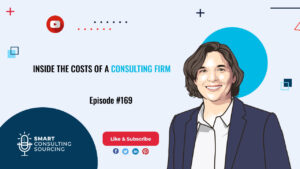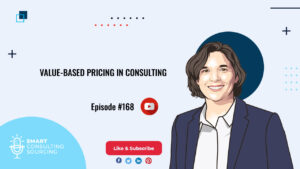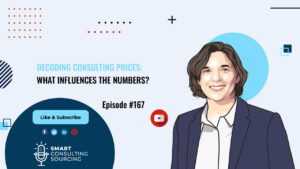In today’s episode of our 6-Levers episode, I’m going to discuss the consulting procurement toolbox. The techniques and tools behind the six levers.
But before that, here is a brief recap of our last 6-Lever series episode.
Last week’s episode focused on “Consulting Performance Scanner“, designed to help stakeholders cultivate a better understanding of their consulting investments. This tool ensures that data from different departments across the organization is factored into reaching maximum ROI and outlines critical criteria, such as validations and supplier performance evaluations, necessary for informed decision-making.
Leveraging existing organizational structure is critical to optimizing spending. Setting boundaries and thresholds can help weed out outliers that don’t meet the criteria, unlocking newfound opportunities for specialized professionals, which leads to higher ROI in consulting services procurement initiatives with greater efficiency and insight-driven decision-making processes.
In a nutshell, you will be able to make intelligent decisions while creating transparency throughout multiple levels of operations!
When you work on optimizing the ROI of your consulting spend, you want to review and activate the 6 levers we described in the previous episodes. But these levers are based on specific tools and methodologies. Today’s episode introduces you to the Consulting Sourcing Toolbox: a comprehensive collection of tools dedicated to helping you effectively optimize consulting spend.
The toolbox includes tools such as make-or-buy strategy, demand management, or supplier relationship management. So indeed, these are typical procurement strategies that you probably already know, but with a twist. Here we are talking about an integrated consulting procurement model that helps you maximize the ROI of your spend.
We can regroup these tools into 4 main categories, which are the dimensions of our consulting procurement maturity grid. So we have Strategy, Governance & Organization, Sourcing Processes, Category management, and Enablers.
Let’s dive deeper into each category and what tools they contain.
But let’s start with the basics.
Leveraging Strategy, Organization, and Governance Tools in Your Consulting Sourcing Tool Box
The first category, Strategy, Organization, and Governance, describes the choices and priorities made by your organization to achieve your ambitions, the set of formal rules and structure that guides decision-making, and the way teams are structured and managed within the company.
The congruence of these areas is essential to build a successful consulting procurement capability.
In other words, how are decisions made when buying consulting services, who is involved, and how is consulting supporting the overall strategy?
Consulting Strategy: Strategy and consulting often go hand-in-hand when it comes to success. So when you have built your strategy, you need to start thinking about how to deliver, and more precisely, you can use consulting to go faster and higher.
So, when thinking through your consulting strategy, consider project initiatives that need to be launched, how you want to segment them into bite-sized efforts, and which particular skill sets you to need at the table.
Now, you need to decide on the best delivery strategy for your initiatives. It is important to understand your options and define which ones make sense for you: you are building your make-or-buy strategy. You should consider all the options available in the market to get expert opinions and advice, such as market research directly accessible, consulting marketplaces, and expert networks.
An internal consulting group can also be beneficial in terms of cost-effectiveness and long-term value. To ensure the most cost-effective and appropriate way forward, make sure that you analyze each project strategically before deciding on whether or not to make or buy.
Now, demand management – it’s all about staying focused on the most critical projects and ensuring that those commitments are realized. To ensure that organizations have the best chance at success, they need to create a decision-making process focused on the projects with the highest return on investment.
This ensures that resources are used efficiently and will assist in realizing business goals as effectively as possible.
When determining how an organization should handle consulting procurement, it’s crucial to assess the critical mass within the organization first. Do we have enough demand and volume? From here, you have to decide on a strategy – centralize, decentralize, or something in between.
Who would be best suited for this role? Is there a need for specialized skills and expertise? Having a clear understanding of the objectives will help determine who to have on board, ensuring that your organization is best positioned to make sound decisions around consulting procurement.
Sourcing Process: The Crucial Second Category in Your Consulting Sourcing Toolbox
The sourcing process describes how consulting services are purchased from need to completion. Internal stakeholders may have difficulties articulating their objectives or be unclear about the process. As a result, the consulting sourcing process can be inefficient and frustrating for all parties.
Is the consulting sourcing process adapted to consulting services> Do you have the right steps> Is it adequate for the volume of projects you handle?
RFPs, or Request for Proposal, processes are essential for any project planning — whether it should be outsourced to external consultants or not. Although there may not always be formal competition to identify the appropriate consulting firm needed to complete the project, RFP processes should still be implemented.
This ensures stakeholder alignment and sets clear expectations for the consultants involved. RFP processes allow us to define our needs better, identify the skills needed and make managing projects far easier – so we can focus on only the must-haves while setting clear goals/deliverables and timelines. Ultimately, this will have a higher ROI, satisfying all stakeholders in the end!
When it comes to sourcing consulting services, it’s important to keep in mind that the process is often different than sourcing for other categories, like travel or office supplies. The key steps of the sourcing process should be tailored to the specific needs of the consulting category.
A major difference with traditional indirect categories is that value in this category often resides more in the scoping and selection phases as opposed to negotiations. This is due to the highly intangible nature of consulting services, not just in terms of what is being sourced but also how the price gets linked with scope, staffing, and timelines – all variables which require a targeted approach during negotiations. To ensure success and get good results from your consulting project, decision-making, and sourcing processes must reflect this understanding.
It’s easy to overlook confidentiality when bringing on a consultant, thinking you have the upper hand regarding knowledge and power. However, no matter the size of the consulting job, from a standard operational project to something more critical like an M&A screening, it’s important to take specific steps to safeguard any confidential information your company is sharing.
Companies must establish a systemized process using NDAs to protect proprietary information and trade secrets. Different options are available, such as long-term NDAs, ad-hoc project NDAs or even comprehensive confidentiality clauses in master service agreements. When done properly, this additional layer of protection through NDAs reduces risk and allows the successful completion of the sourcing process and objectives between companies and their consultants.
Contract management can be complex and daunting, but it is integral to any business activity. You can gain the upper hand in negotiations by taking control of the contract terms and conditions with your suppliers. Establishing master service agreements (MSA) with your leading suppliers is a great way to set the tone for your contract topics – don’t let them dictate their own terms to you!
Furthermore, having contract templates based on the type of project ready can make contract management smoother, faster and more transparent. Appeal to the support of your legal team as needed; colleagues who specialize in contract law may have invaluable insights that can help you make informed decisions. Contract management is a powerful tool, so go ahead and take control now!
What other tools can be used in the sourcing process to ensure that you work with the right consultants? Launching competition whenever relevant is one way to round out a robust toolbox. It’s also wise to check references systematically; this provides transparency and insight into what other projects each consulting firm has worked on with success.
Taking things one step further, consider exploring more sophisticated fee structures such as value-sharing or performance-based fees to ensure complete alignment between your interests and those of the consultants. Bottom line: If you embark on a sourcing process, make sure other tools are at your disposal!
Now to the Third Category: Leveraging Category Management
This is no rocket science. Category Management is a strategic approach to procurement. It’s where organizations segment their spend into areas that contain similar or related services.
How is your organization leveraging category management principles for the consulting category?
Spend analysis is the key to improving ROI for consulting services, yet it can be difficult to do when centralization of spend data isn’t possible. However, with visibility into who, what, and how much you’re spending with each partner and vendor, you can ensure you’re meeting return on investment goals while leveraging the right services to help your business succeed.
Spend analysis enables organizations to accurately measure performance based on their actual costs so they can adjust accordingly. As Deming said, “You can’t improve what you can’t measure” – and it’s true when it comes to consulting services. Spend analysis is the alpha and omega of effective sourcing of consulting services.
Market Knowledge is an absolute necessity in today’s business world, however, it can be both vast and very scattered. Clients often know only 10-15 firms when there are thousands available. Market knowledge is further hindered by asymmetrical information dynamics, meaning consultants know far more about their craft than consulting buyers or users will ever understand.
The key to taking the upper hand in this context lies in exploring the market, understanding cost breakdowns, and pricing strategies, building benchmarks and identifying new entrants and alternatives. Market Knowledge can prove immensely beneficial for those who take the time to develop a strong understanding of it.
Supplier performance is key – knowing who provides the best services for your company can help you succeed. When assessing suppliers, take into consideration multiple aspects of their performance. Project management, impact, level of expertise, relationships, and trust are just a few dimensions to consider.
After each completed project, it’s a good idea to collect feedback from the supplier as well as provide constructive feedback yourselves. This will help build an understanding between the two parties and create improvement plans for future projects.
Of course, it’s important to also address any providers that fail to deliver satisfactory results – staying on top of supplier performance is vital for keeping your company at its best. Consulting may be intangible, but in order for it to be effective, there must always be an active effort to measure supplier performance on many levels.
Preferred Supplier Lists are a great way to manage your company’s relationship with suppliers while ensuring that all of your needs are met. For a Preferred Supplier List (PSL) to work effectively, at least 80 percent of your current needs should be covered necessitating less than 20% for spot projects with new suppliers. But the list should not just exist for the sake of having it drawn up; make use of the data from the spend analysis to segment the supplier panel and identify which suppliers you’d like to keep based on performance and value, as well as determine those that could benefit from being replaced or complemented by newer faces. Furthermore, anticipate the needs of internal stakeholders, so you can begin building relationships that will eventually allow you to negotiate Master Service Agreements with strategic suppliers and get discounts/rebates for bigger volumes. So getting an effective Preferred Supplier List in place is more than just about numbers; it’s essential in improving quality and driving value.
When it comes to category management, other tools in its toolbox include Supplier Relationship or SRM, Tail Spend Management, and Continuous Improvement. SRM is all about maintaining healthy relationships with suppliers and encouraging mutually beneficial deals. Tail Spend Management helps categorize the minor spending levels, which can quickly add up to larger sums down the line. Lastly, Continuous Improvement is a keystone for success in any marketplace as long-term solutions created through continual iterations become normalized for higher efficiency. And yes, it applies to consulting due to the positive impact of intimacy and regular touch-points.
Finally, the Last Category of Your Consulting Sourcing Toolbox is What We Call Enablers.
Let’s begin by explaining what an enabler is. An enabler is any system, team, or process that helps drive and optimize the procurement of consulting services. This includes platforms, tools, and technologies that streamline operations and teams to manage them. Enablers also include performance metrics, scorecards, and operating models to help ensure that processes are efficient and optimized. With these enablers in place, companies can maximize the efficiency and success of their consulting procurement operations.
Let’s look at a few examples: it can be a taxonomy of consulting capabilities that describes the different types of consulting services used in the company. It can also be a spend management dashboard that gives procurement an instant overview of the situation and forecasts. It can also be a handbook for consulting buyers that explain each step of the process based on the type of project.
And it can, of course, be a digital procurement platform that automates the procurement process and facilitates the category’s management.
Here you go, all the tools in our consulting procurement toolbox. Now you have everything you need to get started on the right foot. So let’s keep this conversation going and start building your consulting procurement capability to maximize the ROI of your consulting spend.
So we’ve covered a lot of ground regarding improving the ROI of your consulting spend.
To sum it up, the tools we’ve discussed today – organized into four categories: strategy, organization and governance, sourcing process, category management principles, and enablers – provide a comprehensive framework for optimizing your consulting spend.
Regarding strategy, it’s essential to focus on consulting and use it on suitable projects. Demand management is critical here, and you want to ensure that your team structures and formal rules are aligned with your organization’s ambitions.
The sourcing process is another critical area to focus on. By tailoring the steps to the needs of the consulting category and using RFP processes to align stakeholders, you can establish confidentiality through NDAs and take control over negotiations with suppliers. Don’t forget to leverage competition when relevant and check references systematically. Consider value-sharing or performance fee structures, too!
Category management principles are also essential for improving ROI. Spend analysis is key, as is market knowledge necessary for understanding cost breakdowns and pricing strategies. Supplier performance is essential, so assess project management, impact level, and expertise, among other factors. Preferred supplier lists can help manage relationships while meeting your company’s needs.
And finally, enablers like platforms, tools, teams, processes, and performance metrics can optimize the procurement of consulting services for maximum efficiency and success.
With all of these tools at your disposal, you’re well on your way to improving the ROI of your consulting spend. And if you need any help, don’t hesitate to reach out. I’m here to help you succeed!
And that concludes this episode. Until then, stay safe and happy sourcing, and if you have any questions regarding today’s topic or anything consulting procurement-related, remember you can always contact Helene directly on LinkedIn or by email because she’s always game for a chat and stays connected with us through our community on LinkedIn and follow our Twitter handle @ConsQuest.
Don’t forget to like and subscribe to our channels!
Podbean
YouTube
Happy Sourcing!







